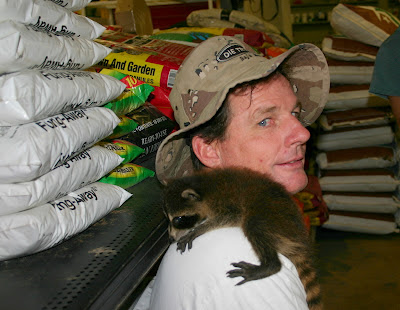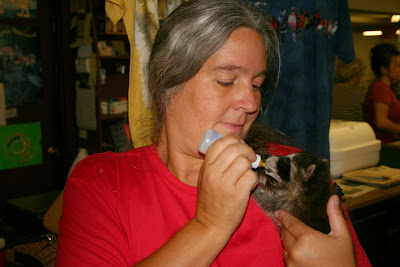Saturday, May 5, 2012
Rabies
Rabies, from the Latin word meaning "madness", is a viral disease transmitted from animals to humans that travels to the brain and then through the central nervous system. It is primarily caused by bites or scratches from an infected animal - the saliva is transmitted through a break in the skin or mucous membranes such as eyes, nose and mouth.
In the U.S. raccoons are the most common animal infected with rabies, but skunks, bats, foxes and coyotes are also carriers. Bats are responsible for the transmission of almost all reported cases of rabies here in the United States. Worldwide, dogs cause the majority of cases of rabies infection, but because of public awareness and widespread vaccinations, great strides are being made to control the disease.
Animals infected with rabies may appear sick, crazed or vicious, but they may also seem unusually tame and gentle. A nocturnal animal that is out wandering during daylight hours or a normally shy wild animal that acts strangely or confused with no fear of humans can be an indication of a rabid animal. You may notice an infected animal drooling, staggering or walking unsteadily. The only sure way to know if an animal is infected with rabies is to have it tested.
Once a person is infected with the rabies virus, symptoms may not occur for up to one year. These include: flu-like symptoms of fever, chills, aches, headache, pain, itching or numbness at the infection site, or anxiety which worsens as the disease progresses. Once the symptoms appear the disease is almost always fatal which is why it is so important, if exposed to the rabies virus, to get medical attention immediately.
Treatment includes a series of vaccinations - 5 doses over a period of 28 days.
In the summer of 2005 we were visiting our farm for the weekend. It was late on a Sunday afternoon and my husband had gone down to the creek while the kids and I were enjoying our last few hours at the farm before getting ready to head back into town. I heard Bob yell, "Marcy - get my gun!" It was just like the scene out of Old Yeller - "Travis! Get the gun!" and I assumed that he had seen another snake (we had had an encounter with a large Diamondback Rattlesnake recently) so I mosied around in no hurry looking for his gun. When I found it I walked down the ravine to where he was at the creek, and there, in the V of a tree trunk, just across the creek about 30 feet away was a raccoon. Let me begin by saying that I LOVE raccoons! They are one of my most favorite animals, and after reading Rascal as a young child I have always dreamed of having my own pet raccoon. But I took one look at the state of this animal and vehemently said, "Shoot it!" This raccoon was spread eagle in the trunk of the tree, crazed, snarling and absolutely demonic looking. So unlike a normal, cute, little raccoon that I would otherwise fawn over.
Bob shot twice and it was over. He said that he had been down at the creek and this animal had come up from downstream and had charged him. He turned to leave and realized that the unusual behavior - aggression, charging and being out during daylight was indicative of a rabid animal and he couldn't just leave it there. So he kept his distance and called for his gun. The raccoon charged him several more times but then crossed the creek and began chewing plastic on the ground before settling in the tree.
After putting it down, Bob went across the small creek, picked up the raccoon by the leg and carried it up the hill. We decided that we would drop it off at the fire-station on the way in to town: surely they would know what to do with it, but found that they were unwilling to take it. We were told that we should take it into town and call Animal Control. Of course, by this time all offices were closed.
The next morning Bob went to work and I was left with the raccoon detail, which had been placed in a garbage bag by the trash. I spoke with an animal control representative and explained the situation and he told me that they would not be able to test the animal for the rabies virus. He said that they had already exceeded their limit for rabies testing for the year (it was only June!) and could no longer submit potential specimens for testing. He said that most likely the raccoon was rabid and that I should dig a very deep hole to bury it in right away. So deep that another animal would not dig it up.
Ha, I thought, I'm not gonna do that! It was June in Florida - very hot, humid and I was just not going to go outside and dig to China. Sorry to say, I planned to throw this thing into the dumpster. Just as we finished our conversation, almost as an afterthought, the Animal Control agent asked, "Did anyone touch this animal with their hands?"
""Yes," I replied, "my husband carried it to the truck."
His immediate response was, "I'll be right over!"
Without thinking I told my young son to go get the garbage bag out of the trash and set it in the shade by the house.
When the agent got there I was horrified to see that the bag holding the dead raccoon was ripped and torn - not the strong, sturdy bag I imagined it had been put into.
To make a long story shorter, the raccoon was taken, tested and proved positive for the rabies virus. Because my husband had touched it and as a home re-modeler he continuously has cuts and abrasions on his hands, allowing for the potential transfer of saliva, it was insisted that he be treated for rabies. And then, also, because I had involved my son in the transfer of the infected animal and there was no way to be positive that he was not scratched in the moving, my boy also had to have the series of shots.
They were administered by the Health department from Florida to New Jersey where we traveled for a family reunion during the 28 day treatment period.
Four months later we were exposed to raccoons once again - baby raccoons, and ironically, this time one was offered to me to keep as a pet. Not because of the rabies, but more to common sense than heart-longing, I declined. I knew I could never keep a raccoon caged and if not keep in a cage it would undoubtedly completely destroy my house - specifically my many boxes of photographs and scrapbook materials. But oh, I'll bet the Health Department would have a fit if they saw these pictures!
Rabies is much more common than you might think. It is found in both wild and domestic animals not confined to the country, but also prevalent in the suburbs and in cities. In our county in NW Florida there have been many confirmed cases of rabies in the past year. So much so that I recently updated our dogs' vaccinations. When administered by a veterinarian, they can be good for up to three years.
Labels:
Farm Stories,
Rabies
Subscribe to:
Post Comments (Atom)






No comments:
Post a Comment